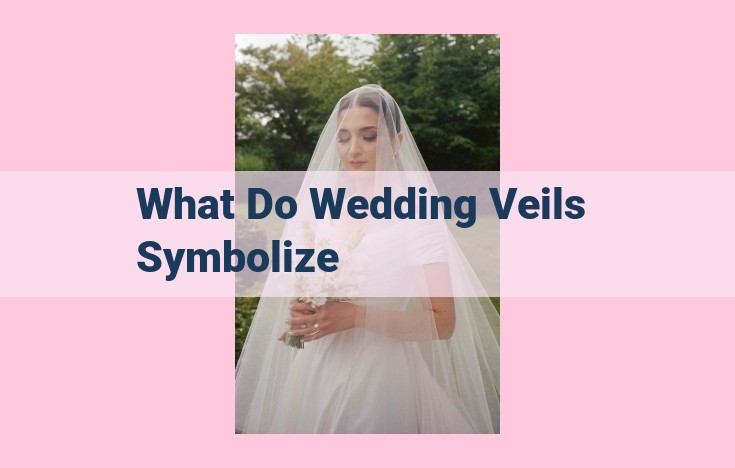Wedding Veils: Unveiling Symbolism, History, And Cultural Significance

Wedding veils symbolize a confluence of religious and cultural influences. They represent the ideals of female modesty, purity, and virtue, as espoused by various religions like Christianity, Judaism, and Islam. Furthermore, they embody cultural ideals of elegance and beauty, drawing inspiration from Victorian and Medieval European traditions that emphasized female protection and modesty.
Religious Influences: The Pillars of Female Modesty
Throughout history, religious teachings have profoundly influenced cultural expectations and norms regarding female modesty. Across major faiths, such as Christianity, Judaism, and Islam, we find common threads that underscore the significance of women’s dress and behavior.
Christianity: The Pauline Legacy
In Christianity, the apostle Paul’s writings have shaped the concept of female modesty. In his epistles to Timothy, Paul exhorts women to dress “in modest apparel with propriety and self-control” (1 Timothy 2:9). This passage has been interpreted as a directive for women to cover their bodies and avoid attention-grabbing clothing.
Judaism: From the Torah to Orthodox Practices
In Judaism, modesty is a virtue rooted in the Torah. The book of Deuteronomy (22:5) states that “a woman shall not wear a man’s apparel, nor shall a man put on a woman’s garment.” This law reflects the belief that gender-appropriate clothing maintains social harmony and preserves the sanctity of marriage. In Orthodox Jewish communities, women often adhere to strict dress codes that include head coverings and modest clothing.
Islam: The Hijab and Islamic Law
Within Islam, the concept of modesty is deeply embedded in Sharia law. The Quran (24:31) instructs women to “draw their veils over their bosoms.” The hijab, or headscarf, is a widely recognized symbol of female modesty in Islamic cultures. By covering their hair and bodies, Muslim women seek to comply with religious principles and maintain personal dignity.
These religious teachings have left an undeniable imprint on societies around the world, shaping cultural ideals and expectations regarding female modesty. From the conservative dress codes of Victorian England to the veiling practices of Islamic countries, religious beliefs continue to influence the way women dress and present themselves.
**Cultural Ideals: The Virtuous Image of Modesty**
Throughout history and across cultures, the virtue of modesty has held a profound influence on societies’ expectations of women. These ideals have been deeply ingrained in our notions of purity, innocence, elegance, and beauty.
From the graceful heroines of Jane Austen’s novels to the demure saints depicted in religious art, literature and the arts have played a pivotal role in shaping our understanding of what it means to be a modest woman. Purity and innocence have often been associated with virginity and chastity, while modesty has been expressed in the way women dress, speak, and behave.
Moreover, humility and elegance have been considered virtues that enhance a woman’s overall demeanor. Beauty, while certainly valued, has often been tempered by an emphasis on modesty. These ideals continue to influence societal expectations, informing our views on what constitutes appropriate behavior and attire for women.
Protection and Tradition: Layers of Modesty
Unveiling the Historical Threads of Female Modesty
Female modesty, a concept deeply rooted in history and tradition, has woven its way across various cultures and time periods. Its origins can be traced back to the Victorian era of England and the medieval period in Europe. During these times, women’s modesty was seen as a virtue, a form of protection, and a reflection of their virtue.
The Victorian Era: A Veil of Propriety
The Victorian era, known for its strict social norms, placed a strong emphasis on female modesty. Women were expected to cover their bodies, both in public and private, as a means of guarding their chastity and virtue. This modesty was expressed through long, elaborate dresses, high necklines, and gloves. It was believed that any display of skin could tempt men and lead to immoral behavior.
Medieval Europe: Chivalry and Honor
In medieval Europe, female modesty was tied to the concept of chivalry. Knights were expected to protect and defend women, who were seen as vulnerable and in need of protection. Modesty was a way of shielding women from unwanted attention and safeguarding their honor and reputation. Women were expected to dress modestly, cover their hair, and avoid public places unaccompanied.
Motivations Behind Modesty Measures
These historical conceptions of female modesty were driven by a complex mix of motivations and societal norms. One primary motivation was to protect women from potential sexual harassment or assault. By covering their bodies, women were less likely to attract unwanted male attention and could move about society more safely.
Another motivation was the belief that female modesty promoted moral and social order. By adhering to strict dress codes, women were seen as upholding the values of society and contributing to its stability and harmony. These societal expectations placed a heavy burden on women, limiting their freedom of expression and choice.
Unraveling the Layers of Tradition
Over time, the concept of female modesty has evolved and changed, though its historical roots continue to influence cultural norms and expectations. In some cultures, modesty remains a deeply ingrained value, while in others, it has become a more flexible concept.
Today, female modesty may be expressed in a variety of ways, depending on cultural and personal beliefs. Some women choose to dress modestly out of a sense of tradition, religion, or personal preference. Others may reject traditional notions of modesty, believing that women should have the right to dress freely and express their individuality.
As society continues to evolve, the concept of female modesty will likely continue to be debated and redefined. However, the historical roots of this concept offer a fascinating glimpse into how cultural norms, societal expectations, and the desire for protection and privacy have shaped the way women have been viewed and treated throughout history.